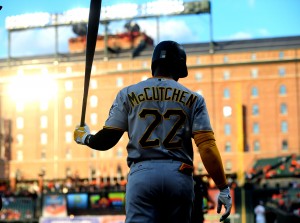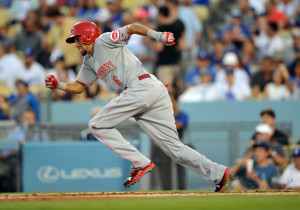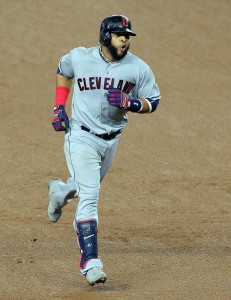MLBTR is publishing Offseason Outlooks for all 30 teams. Click here to read the other entries in this series.
The 2017 season was the 16th in a row that ended after Game 162 for the Mariners, who finished 78-84 to extend their major league-worst playoff drought. A series of injuries to integral performers contributed to Seattle’s woes this year, though, leaving general manager Jerry Dipoto and CEO John Stanton optimistic that a healthier Mariners club could make a postseason push in 2018. But first, Dipoto will spend the next few months working to build a better roster than the one he constructed heading into the 2017 campaign.
Guaranteed Contracts
- Robinson Cano, 2B: $144MM through 2023
- Kyle Seager, 3B: $74.5MM through 2021
- Jean Segura, SS: $67MM through 2023
- Felix Hernandez, SP: $54.7MM through 2019
- Mike Leake, SP: $36MM through 2021
- Nelson Cruz, DH: $14MM through 2018
- Marc Rzepczynski, RP: $5.5MM through 2018
Contract Options
- Yovani Gallardo, SP: $13MM club option or $2MM buyout
- Hisashi Iwakuma, SP: $10MM club option or $1MM buyout
Arbitration-Eligible Players (service time in parentheses; projections via MLBTR contributor Matt Swartz)
- David Phelps (5.156) – $5.8MM
- Drew Smyly (5.154) – $6.85MM
- Erasmo Ramirez (4.158) – $4.7MM
- Nick Vincent (4.067) – $2.7MM
- Mike Zunino (3.161) – $3.2MM
- James Paxton (3.151) – $5.6MM
- Shae Simmons (3.111) – $700K
- Non-tender candidates: Smyly
Free Agents
[Mariners Depth Chart; Mariners Payroll Information]
As you’d expect, injuries weren’t the lone culprit for the Mariners’ sub-.500 finish this year. However, they did play a big part in the Mariners’ weakest aspect – their starting staff. Entering the season, the plan was for James Paxton, Felix Hernandez, Hisashi Iwakuma and winter trade acquisitions Drew Smyly and Yovani Gallardo to eat up the lion’s share of innings from the M’s rotation. Instead, the quintet combined for a mere 368 1/3 frames – roughly 73 apiece – and Paxton was the sole standout when he actually took the mound. Arm problems prevented the promising Smyly from pitching at all, and after undergoing Tommy John surgery in July, he looks like a surefire non-tender. Iwakuma also had an abbreviated year, making just six starts and amassing 31 innings, and is now recovering from September shoulder surgery. He’ll receive his walking papers in the form of a buyout, as will Gallardo, who pitched to a bloated ERA (5.73) over 130 2/3 innings spent between the rotation and bullpen.
While three-fifths of their planned rotation from 2017 is on the cusp of exiting, the Mariners still have three locks to win starting spots next season. Paxton is the unquestioned ace, a distinction that went to Hernandez before him. King Felix has fallen off dramatically over the past couple seasons, but the superstar-type money left on the soon-to-be 32-year-old’s contract and his full no-trade clause indicate he’s not going anywhere. And then there’s Mike Leake, whom the Mariners acquired from the Cardinals in an end-of-August trade. While Leake was tremendous down the stretch with his new team (2.53 ERA, 2.25 FIP in 32 innings), the elite-caliber production he logged during that small sample is an aberration relative to his career. Still, even if Leake regresses toward his lifetime output next season (3.98 ERA, 4.12 FIP), the longtime innings eater will still give the Mariners a durable mid-rotation type. There’s plenty of value in that for a team whose innings leader in 2017 was Ariel Miranda, a back-end starter who accrued 158 frames. Leake hasn’t thrown fewer innings than that in a season since his rookie year, 2010, when he racked up 138 1/3.
It’s unclear what the Mariners’ rotation will look like beyond Paxton, Hernandez and Leake next year, though Dipoto declared earlier this month that he’s satisfied with the “depth” and “quality” on hand. With Erasmo Ramirez, Andrew Moore, Andrew Albers, Ariel Miranda and Marco Gonzales around, the Mariners will go into 2018 with several in-house candidates for the final two sports in their rotation. It’s not the most confidence-inspiring group, however, which means it would behoove the Mariners to seek outside upgrades.
Considering the Mariners lack even a mid-tier farm system, putting together a trade for a controllable, young starter may be unrealistic. But they could add one in free agency if Japanese sensation Shohei Otani immigrates to the majors, as he’s expected to do. Thanks to the international spending limitations in the new collective bargaining agreement, the 23-year-old ace/slugger figures to have all 30 teams vying for his services should he reach the market. The amount of competition will make it especially difficult for any team to reel in Otani, then, but Bob Dutton of the Tacoma News Tribune did report earlier this month that Seattle plans to aggressively pursue him.
It may not affect the Otani chase, but it’s still worth noting that the Mariners have had success picking up Japanese talent in the past, having added Iwakuma, future Hall of Famer Ichiro Suzuki and Kazuhiro Sasaki. Unlike any of those players, Otani comes with the unique ability to make an impact both on the mound and with his bat. Otani will primarily serve as a pitcher if he comes to the majors, but he’s likely to sign with a team that will give him the ability to showcase his offensive skills. As an American League club, the Mariners theoretically have a leg up on half of the majors because they can offer Otani at-bats as a designated hitter. Of course, with Nelson Cruz entrenched at DH for another year, Otani probably wouldn’t have a chance to do much at the plate until 2019 if he chooses the Mariners.
Aside from Otani, the premier impending free agent starters will include Yu Darvish, Jake Arrieta, and, if he opts out of his contract with the Yankees, Masahiro Tanaka. Otani happens to idolize Darvish, setting up the possibility of those two going somewhere as a sort of package deal. The problem for Seattle, if it tries to go after Darvish, Arrieta or Tanaka, is that it doesn’t seem to have the financial wiggle room to make a big splash. While the Mariners’ payroll does have “room for growth,” according to Stanton, it’s unclear how much more they’re willing to spend after opening 2017 with a franchise-record $154MM in commitments. Regardless, the vast majority of the Mariners’ 2018 money is already spoken for, with a handful of veterans on large contracts and several more due raises in arbitration. The Mariners could still get creative in order to sign Darvish, as John Truplin of Lookout Landing wrote this week, but doing so would make it tough for them to adequately address other problems on the roster.
As with Darvish, Arrieta and Tanaka, signing a second-tier starter such as Lance Lynn or Alex Cobb may also prove too costly. But there will be some other potentially useful options on the market at lesser prices, including hard-throwing, groundball-inducing Tyler Chatwood, former Mariners Doug Fister, Jason Vargas and Chris Tillman, and Jaime Garcia, to name a few.
While a major addition to the Mariners’ rotation at least looks somewhat possible, albeit unlikely, their bullpen probably doesn’t need one. The Mariners’ relievers only earned modest rankings in ERA (13th) and fWAR (15th) this year, but Edwin Diaz, Nick Vincent, Emilio Pagan, Tony Zych, Marc Rzepczynski and James Pazos are either shoo-ins or strong bets to factor into their Opening Day plans next season. And with no minor league options remaining for Ramirez or Gonzales, at least one could end up in the bullpen if beginning the year from the rotation doesn’t prove to be in the cards. Beyond those names, Shae Simmons, Dan Altavilla, Ryan Garton and Thyago Vieira are also among those in the organization who could push for big league relief roles.
Similarly, the majority of the Mariners’ position player group is locked in going into next year. Cruz, second baseman Robinson Cano, third baseman Kyle Seager, shortstop Jean Segura, outfielder Mitch Haniger and catcher Mike Zunino will be integral pieces again. They’re going to need complements at first base and in the outfield, though.
Going by fWAR (minus-0.7), nobody was worse off at first this year than Seattle, but soon-to-be free agent Danny Valencia’s lackluster output was the primary reason for that. On the other hand, August acquisition Yonder Alonso fared decently (.265/.353/.439 in 150 plate appearances), though he’s also scheduled to hit free agency. He and the Mariners are interested in working out a new deal, per Greg Johns of MLB.com; failing that, the club could look elsewhere to a free agent market that will include first base types ranging from expensive to reasonably priced in Eric Hosmer, Carlos Santana, Jay Bruce, ex-Mariner Logan Morrison, Lucas Duda and Mitch Moreland. Alternatively, Dipoto may go his signature route – the trade market – for help, with the Braves’ Matt Adams standing out as a possible mover who wouldn’t require much in return.
Some of those names, including the lefty-swinging Alonso, aren’t all that effective against same-handed pitchers. Perhaps it would make sense, then, to bring back the right-handed Valencia as a platoon first baseman, given how well he has performed versus southpaws in his career (.313/.370/.493 in 994 PAs). Otherwise, Mike Napoli, Mark Reynolds, Matt Holliday and Jose Bautista are fellow righty-hitting free agents with the potential to fill that role, though Reynolds is the only member of the group who isn’t coming off a poor season.
Meanwhile, it’s anyone’s guess who will join Haniger to comprise the Mariners’ starting outfield. It’s also to be determined whether Haniger will line up at his typical 2017 spot – right field – or shift to center. Whether that happens could depend on the future of center fielder Jarrod Dyson, arguably the Mariners’ best free agent-to-be. While Dyson will turn 34 next August and doesn’t bring any power to the table, his defensive and baserunning prowess – not to mention his respectable on-base skills – combine to give him a high-floor skillset. Injuries limited Dyson to 111 games and 390 PAs in 2017, his first year as a Mariner, but he still managed upward of 2.0 fWAR for the fourth time in a half-decade. Dyson’s clearly a valuable player, one who’s not going to break the bank this winter, so re-upping him on a short-term deal may be in Seattle’s best interest. If Dyson walks, though, the Mariners will have to replace someone who was easily the leading defender and baserunner on the team in 2017 (notably, despite Dyson’s excellence, the M’s finished toward the bottom of the majors’ in FanGraphs’ BsR metric).
Lorenzo Cain, one of Dyson’s former teammates in Kansas City, will be the premier center fielder available in free agency, but he’s also poised to haul in one of the offseason’s richest paydays. Fellow center fielders Carlos Gomez, Jon Jay, Cameron Maybin and former Mariner Austin Jackson won’t cost nearly as much as Cain, though Dyson is arguably more appealing than each of those four. As for center field-capable trade candidates, there’s Christian Yelich (Marlins), Marcell Ozuna (Marlins), Billy Hamilton (Reds), Keon Broxton (Brewers) and Randal Grichuk (Cardinals). The Mariners probably don’t have the prospect capital to win a bidding war for either Yelich or Ozuna, however, and Hamilton, Broxton and Grichuk all posted sub-.300 on-base percentages in 2017. That could deter Dipoto, who highly values OBP.
Even with Haniger and either Dyson or his successor in the mix, the Mariners may still need help in the grass. Ben Gamel and Guillermo Heredia combined for just 1.6 fWAR (all from Gamel) in 976 PAs, after all, and the former declined sharply at the plate in the second half of the season. Both players are dirt cheap and fairly young, which could convince the Mariners to give them a large amount of rope again in 2018. Still, there’s a variety of corner outfield options slated to reach free agency – including J.D. Martinez and possibly Justin Upton, whom Dipoto knows from their time together in Arizona – and some would at least make for useful bench pieces (Rajai Davis would fit a team in need of a baserunning boost, for instance) if the Mariners don’t shop for a bona fide starter.
The Mariners do appear to have a legitimate starter behind the plate in Zunino, the No. 3 pick in the 2012 draft who has moved past his early career struggles to emerge as an upper-tier backstop since last season. He’ll need a new backup, however, unless the Mariners re-sign respected veteran Carlos Ruiz. Whether it’s Ruiz or someone else, any catcher the Mariners tab for the No. 2 role likely isn’t going to play much next season – which makes it a low-priority need (but a need nonetheless) entering the winter.
This may prove to be a make-or-break offseason for Dipoto, who’s entering the final year of his contract. Putting together a team that at least seriously competes for a wild-card spot in 2018 could be enough to save his job, but it appears he’ll have to make improvements this winter without a ton of spending room. The good news for Dipoto is that the Mariners aren’t exactly devoid of talent, meaning he shouldn’t have to do anything drastic for them to end up as playoff contenders next season.



